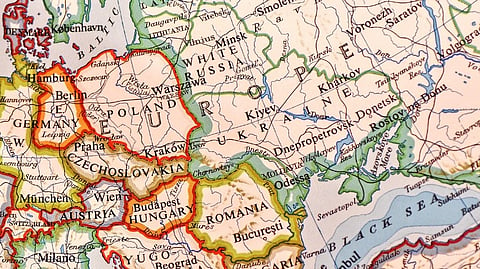

The European Union will on Thursday agree in principle to provide Ukraine with the financing it needs for the next two years, EU Council chief Antonio Costa said, despite a Belgian threat to block a plan to use Russian frozen assets to aid Kyiv.
Arriving at a summit of EU leaders in Brussels, Belgian Prime Minister Bart De Wever laid out three demands for the use of Russian immobilised assets to provide a €140 billion ($163 billion) loan to Ukraine.
"If demands are met, we can go forward. If not I will do everything in my power at the European level, also at the national level, politically and legally to stop this decision," said De Wever, whose country holds the frozen assets that would be used in the scheme, via securities depository Euroclear.
De Wever called on all EU members to share the risks associated with the plan, meaning they would share the costs of any legal action pursued by Russia and contribute financially if the money ever had to be paid back.
He also said Russian frozen assets held by other countries should be part of the scheme.
"There must be transparency about the risk. There must be transparency about the legal basis for this decision," he said.
But Costa, arriving at the summit with Ukrainian President Volodymyr Zelenskiy, made clear the EU would ensure Kyiv’s financial needs were covered for the next two years, with technical details to be decided later.
"We will take the political decision to ensure the financial needs of Ukraine for 2026 and 2027, including for the acquisition of military equipment," said Costa, who chairs summits of EU leaders.
The leaders are expected to task the European Commission to come up with a formal legal proposal on the frozen assets plan.
At the summit, leaders of the European Union will also reiterate backing for Ukraine’s territorial integrity.
Ukraine’s leader also received a boost in the form of a new package of EU sanctions against Russia which the bloc formally approved on Thursday.
The package includes a ban on Russian liquefied natural gas from January 2027, as well as new measures on the so-called shadow tanker fleet and two independent Chinese oil refineries.
Zelenskiy arrived at the summit after a rollercoaster few days that saw Donald Trump announce and then back away from plans to meet Russia’s Vladimir Putin in Budapest. The planned summit was later put on hold and on Wednesday, the US hit Russia's major oil companies with sanctions.
As he arrived at the EU gathering, Zelenskiy welcomed the US and EU sanctions.
Even before a formal proposal has been made to use the Russian assets frozen after its full-scale invasion of Ukraine in 2022, EU countries have been wrangling over what conditions to impose on the "reparations loan".
Some want all the money to go to Ukraine’s military, with the bulk spent on European weapons. Others say Kyiv should be able to use some of the loan to buy US arms and that the money could also be used for general budget support.
“While there is, I think, a fairly clear political will to move forward, there are still many questions,” said an EU diplomat, speaking on condition of anonymity.
A senior official in Zelenskiy’s administration told Reuters that Ukraine needed the funds by the end of the year and autonomy over how to spend them.
The European Commission suggested a compromise whereby the majority of the loan would be spent on Ukrainian and European weapons but a smaller part would be for general budget support, which Kyiv could also use to buy arms from outside Europe.
Russia has described the idea as an illegal seizure of property and warned of retaliation.
(Reporting by Lili Bayer, Andrew Gray, Julia Payne, Philip Blenkinsop, Sudip Kar-Gupta, Bart Meijer, Benoit Van Overstraeten, Jan Strupczewski, Charlotte Van Campenhout and Inti Landauro in Brussels; Writing by Lily Bayer, Ingrid Melander and Andrew Gray; Editing by Stephen Coates, Kate Mayberry, Aidan Lewis)
